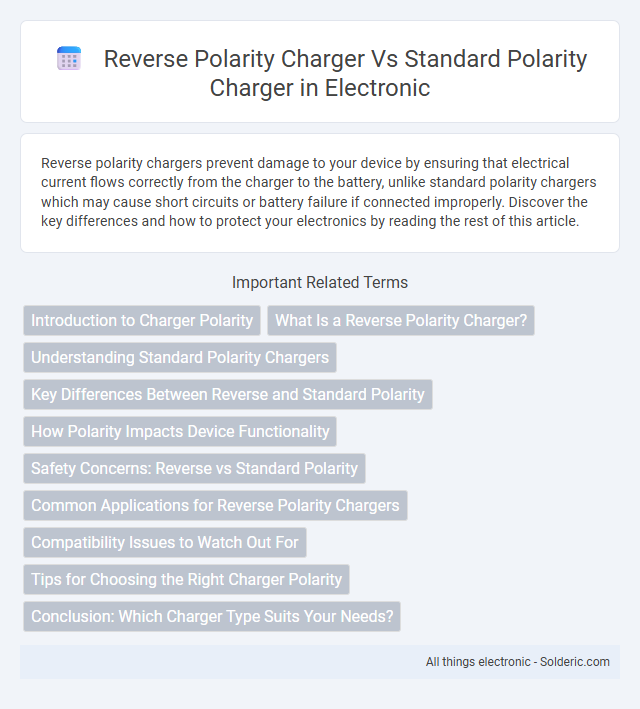Reverse polarity chargers prevent damage to your device by ensuring that electrical current flows correctly from the charger to the battery, unlike standard polarity chargers which may cause short circuits or battery failure if connected improperly. Discover the key differences and how to protect your electronics by reading the rest of this article.
Comparison Table
| Feature | Reverse Polarity Charger | Standard Polarity Charger |
|---|---|---|
| Polarity Protection | Includes reverse polarity protection to prevent damage if connected incorrectly | No reverse polarity protection; incorrect connections can cause damage |
| Usage | Ideal for users who may connect batteries incorrectly | For users confident in correct battery polarity connections |
| Safety | Higher safety due to automatic protection against reversed connections | Lower safety risk if polarity is correctly observed |
| Cost | Generally higher due to added circuitry | Generally lower cost |
| Compatibility | Works safely with both polarities but designed for specific battery types | Designed only for standard polarity connections |
| Application | Common in automotive, motorcycle, and rugged battery charging scenarios | Common in household and general-purpose battery chargers |
Introduction to Charger Polarity
Charger polarity refers to the direction of electrical current flow between the charger and the battery terminals, affecting device compatibility and safety. Reverse polarity chargers deliver current in the opposite direction to standard polarity chargers, which can damage electrical components or batteries if mismatched. Understanding your charger's polarity ensures optimal performance and prevents potential hazards during charging.
What Is a Reverse Polarity Charger?
A reverse polarity charger is a device designed to connect to a battery with the positive and negative terminals reversed, preventing damage caused by incorrect wiring. Unlike standard polarity chargers that require proper alignment of positive to positive and negative to negative terminals, reverse polarity chargers include built-in protection circuits to handle misconnected terminals safely. This feature is essential for avoiding electrical faults, battery damage, or charger failure during charging processes.
Understanding Standard Polarity Chargers
Standard polarity chargers feature a positive terminal that connects to the positive battery post and a negative terminal that connects to the negative post, ensuring correct voltage flow for battery charging. These chargers are designed with built-in safeguards to prevent damage from incorrect connections, providing safe and efficient power delivery. Understanding the wiring and compatibility of standard polarity chargers is essential for maintaining battery health and avoiding electrical hazards.
Key Differences Between Reverse and Standard Polarity
Reverse polarity chargers have their positive and negative terminals swapped compared to standard polarity chargers, which can impact device compatibility and charging efficiency. Standard polarity chargers follow the conventional positive-to-positive and negative-to-negative connection, ensuring safe and consistent power delivery for most electronics. You should always verify your device's polarity requirements to avoid potential damage or malfunction.
How Polarity Impacts Device Functionality
Reverse polarity chargers deliver current with the positive and negative terminals swapped, which can cause malfunction or permanent damage to devices designed for standard polarity charging. Standard polarity chargers ensure correct current flow aligned with device specifications, enabling safe and efficient battery charging and optimal device performance. Polarity impacts device functionality by affecting internal circuit protection, battery chemistry, and overall power management, making polarity matching critical to prevent short circuits or component failure.
Safety Concerns: Reverse vs Standard Polarity
Reverse polarity chargers pose significant safety risks by potentially causing short circuits, battery damage, or even electrical fires if connected improperly. Standard polarity chargers maintain a consistent positive-to-positive and negative-to-negative connection, ensuring safer and more reliable charging without risk of damaging the battery or electrical components. Ensuring correct polarity alignment is crucial to prevent hazards and extend battery lifespan in charging applications.
Common Applications for Reverse Polarity Chargers
Reverse polarity chargers are primarily used in specialized automotive and industrial battery charging systems where protecting electronic components from incorrect polarity connections is crucial. These chargers are common in applications such as off-grid solar power systems, maintenance of deep cycle batteries in marine vessels, and electric vehicle battery management, ensuring safety and prolonging battery life. Standard polarity chargers dominate general consumer electronics and automotive markets where polarity reversal is less of a concern.
Compatibility Issues to Watch Out For
Reverse polarity chargers can cause significant compatibility issues with devices designed for standard polarity, potentially leading to damage or malfunction. Many electronic devices have built-in protection against reverse polarity, but relying on this can risk voiding warranties or causing charging failures. Ensure you verify your device's polarity requirements to avoid damaging your equipment when selecting a charger.
Tips for Choosing the Right Charger Polarity
When selecting between a reverse polarity charger and a standard polarity charger, ensure compatibility with your device's battery specifications to avoid damage and ensure optimal charging efficiency. Check the manufacturer's guidelines or battery label for polarity requirements, as using the wrong charger can lead to malfunctions or reduced battery lifespan. Your best option is to match the charger's polarity with your battery's configuration, safeguarding performance and safety.
Conclusion: Which Charger Type Suits Your Needs?
Choosing between a reverse polarity charger and a standard polarity charger depends on your device's specifications and safety requirements. Reverse polarity chargers prevent damage by ensuring correct current flow alignment, ideal for sensitive electronics, while standard polarity chargers suit conventional devices with straightforward power inputs. Assess your device's compatibility to determine which charger type best meets your needs and protects your investment.
Reverse polarity charger vs standard polarity charger Infographic

 solderic.com
solderic.com